Can Polylactic Acid (PLA) Act as an Important Vector for Triclosan?
Abstract
1. Introduction
2. Materials and Methods
2.1. Materials
2.2. Batch Adsorption Experiments
2.3. TCS Determination
2.4. Data Analysis
3. Results and Discussion
3.1. The Influence of Particle Size of Microplastics
3.2. The Influence of Microplastics Dosage
3.3. The Influence of pH
3.4. The Influence of Salinity
3.5. Adsorption Kinetics
3.6. Adsorption Isotherms
4. Conclusions
Supplementary Materials
Author Contributions
Funding
Institutional Review Board Statement
Informed Consent Statement
Data Availability Statement
Conflicts of Interest
References
- Chang, J.; Fang, W.; Liang, J.; Zhang, P.; Zhang, G.; Zhang, H.; Zhang, Y.; Wang, Q. A critical review on interaction of microplastics with organic contaminants in soil and their ecological risks on soil organisms. Chemosphere 2022, 306, 135573. [Google Scholar] [CrossRef]
- Zhou, Q.; Wang, S.; Liu, J.; Hu, X.; Liu, Y.; He, Y.; He, X.; Wu, X. Geological evolution of offshore pollution and its long-term potential impacts on marine ecosystems. Geosci. Front. 2022, 13, 101427. [Google Scholar] [CrossRef]
- Zhou, J.; Gui, H.; Banfield, C.C.; Wen, Y.; Zang, H.; Dippold, M.A.; Charlton, A.; Jones, D.L. The microplastisphere: Biodegradable microplastics addition alters soil microbial community structure and function. Soil Biol. Biochem. 2021, 156, 108211. [Google Scholar] [CrossRef]
- Fu, L.; Li, J.; Wang, G.; Luan, Y.; Dai, W. Adsorption behavior of organic pollutants on microplastics. Ecotoxicol. Environ. Saf. 2021, 217, 112207. [Google Scholar] [CrossRef]
- Zhou, Q.; Yue, Z.; Li, Q.; Zhou, R.; Liu, L. Exposure to PbSe nanoparticles and male reproductive damage in a rat model. Environ. Sci. Technol. 2019, 53, 13408–13416. [Google Scholar] [CrossRef]
- Zhou, Q.; Ma, S.; Zhan, S. Superior photocatalytic disinfection effect of Ag-3D ordered mesoporous CeO2 under visible light condition. Appl. Catal. B 2018, 224, 27–37. [Google Scholar] [CrossRef]
- Zhou, Q.; Li, D.; Wang, T.; Hu, X. Leaching of graphene oxide nanosheets in simulated soil and their influences on microbial communities. J. Hazard. Mater. 2021, 404, 124046. [Google Scholar] [CrossRef]
- Saini, P.; Arora, M.; Ravi Kumar, M.N.V. Poly(lactic acid) blends in biomedical applications. Adv. Drug Deliv. Rev. 2016, 107, 47–59. [Google Scholar] [CrossRef]
- Murariu, M.; Dubois, P. PLA composites: From production to properties. Adv. Drug Deliv. Rev. 2016, 107, 17–46. [Google Scholar] [CrossRef]
- Zuo, L.Z.; Li, H.X.; Lin, L.; Sun, Y.X.; Diao, Z.H.; Liu, S.; Zhang, Z.Y.; Xu, X.R. Sorption and desorption of phenanthrene on biodegradable poly (butylene adipate co-terephtalate) microplastics. Chemosphere 2019, 215, 25–32. [Google Scholar] [CrossRef]
- Milanović, M.; Đurić, L.; Milošević, N.; Milić, N. Comprehensive insight into triclosan—From widespread occurrence to health outcomes. Environ. Sci. Pollut. Res. 2021, 1–22. [Google Scholar] [CrossRef] [PubMed]
- Wang, D.; Wang, X.; Huang, H.; Wang, H. Triclosan regulates alternative splicing events of nerve-related genes through RNA-binding protein CELF2 to induce zebrafish neurotoxicity. J. Hazard. Mater. 2021, 413, 125414. [Google Scholar] [CrossRef]
- Ka, Y.L.; Zhu, H.Y.; Robert, F.; Adam, J.; Elodie, P. Triclosan uptake and transformation by the green algae Euglena gracilis strain Z. Sci. Total Environ. 2022, 833, 155232. [Google Scholar]
- Tong, H.; Hu, X.; Zhong, X.; Jiang, Q. Adsorption and desorption of triclosan on biodegradable polyhydroxybutyrate microplastics. Environ. Toxicol. Chem. 2021, 40, 72–78. [Google Scholar] [CrossRef] [PubMed]
- Xue, X.; Hong, S.; Cheng, R.; Li, H.; Qiu, L.; Fang, C. Adsorption characteristics of antibiotics on microplastics: The effect of surface contamination with an anionic surfactant. Chemosphere 2022, 307, 136195. [Google Scholar] [CrossRef] [PubMed]
- Costigan, E.; Collins, A.; Hatinoglu, M.; Bhagat, K.; MacRae, J.; Perreault, F.; Apul, O. Adsorption of organic pollutants by microplastics: Overview of a dissonant literature. J. Hazard. Mater. Adv. 2022, 6, 100091. [Google Scholar] [CrossRef]
- Webb, S.; Gaw, S.; Marsden, I.D.; McRae, N.K. Biomarker responses in New Zealand green-lipped mussels perna canaliculus exposed to microplastics and triclosan. Ecotoxicol. Environ. Saf. 2020, 201, 110871. [Google Scholar] [CrossRef] [PubMed]
- Shi, K.; Zhang, H.; Xu, H.M.; Liu, Z.; Kan, G.F.; Yu, K.; Jiang, J. Adsorption behaviors of triclosan by non-biodegradable and biodegradable microplastics: Kinetics and mechanism. Sci. Total Environ. 2022, 842, 156832. [Google Scholar] [CrossRef] [PubMed]
- Zhou, Q.; Liu, Y.; Li, T.; Zhao, H.; Daniel, S.A.; Liu, W.; Kurt, O.K. Cadmium adsorption to clay-microbe aggregates: Implications for marine heavy metals cycling. Geochim. Cosmochim. Acta 2020, 290, 124–136. [Google Scholar] [CrossRef]
- McDougall, L.; Thomson, L.; Brand, S.; Wagstaff, A.; Lawton, L.; Petrie, B. Adsorption of a diverse range of pharmaceuticals to polyethylene microplastics in wastewater and their desorption in environmental matrices. Sci. Total Environ. 2022, 808, 152071. [Google Scholar] [CrossRef]
- Li, J.Y.; Huang, X.T.; Hou, Z.M.; Ding, T.D. Sorption of diclofenac by polystyrene microplastics: Kinetics, isotherms and particle size effects. Chemosphere 2022, 290, 133311. [Google Scholar] [CrossRef]
- Wang, J.; Liu, X.; Liu, G.; Zhang, Z.X.; Wu, H.; Cui, B.S.; Bai, J.H.; Zhang, W. Size effect of polystyrene microplastics on sorption of phenanthrene and nitrobenzene. Ecotoxicol. Environ. Saf. 2019, 173, 331–338. [Google Scholar] [CrossRef] [PubMed]
- Wu, P.F.; Cai, Z.W.; Jin, H.B.; Tang, Y.Y. Adsorption mechanisms of five bisphenol analogues on PVC microplastics. Sci. Total Environ. 2019, 650, 671–678. [Google Scholar] [CrossRef] [PubMed]
- Xu, B.L.; Liu, F.; Brookes, P.C.; Xu, J.M. Microplastics play a minor role in tetracycline sorption in the presence of dissolved organic matter. Environ. Pollut. 2018, 240, 87–94. [Google Scholar] [CrossRef]
- Seidensticker, S.; Grathwohl, P.; Lamprecht, J.; Zarfl, C. A combined experimental and modeling study to evaluate pH-dependent sorption of polar and non-polar compounds to polyethylene and polystyrene microplastics. Environ. Sci. Eur. 2018, 30, 1–12. [Google Scholar] [CrossRef] [PubMed]
- Wang, F.; Shih, K.M.; Li, X.Y. The partition behavior of perfluorooctanesulfonate (PFOS) and perfluorooctanesulfonamide (FOSA) on microplastics. Chemosphere 2015, 119, 841–847. [Google Scholar] [CrossRef]
- Tripathy, S.S.; Kanungo, S.B. Adsorption of Co2+, Ni2+, Cu2+ and Zn2+ from 0.5 M NaCl and major ion sea water on a mixture of δ-MnO2 and amorphous FeOOH. J. Colloid Interface Sci. 2005, 284, 30–38. [Google Scholar] [CrossRef] [PubMed]
- Torres, F.G.; Dioses-Salinas, D.C.; Pizarro-Ortega, C.I.; De-la-Torre, G.E. Sorption of chemical contaminants on degradable and non-degradable microplastics: Recent progress and research trends. Sci. Total Environ. 2021, 757, 143875. [Google Scholar] [CrossRef]
- Hüffer, T.; Hofmann, T. Sorption of non-polar organic compounds by micro-sized plastic particles in aqueous solution. Environ. Pollut. 2016, 214, 194–201. [Google Scholar] [CrossRef] [PubMed]
- Chen, Y.; Li, J.; Wang, F.; Yang, H.; Liu, L. Adsorption of tetracyclines onto polyethylene microplastics: A combined study of experiment and molecular dynamics simulation. Chemosphere 2021, 265, 129133. [Google Scholar] [CrossRef] [PubMed]
- Yu, F.; Yang, C.; Huang, G.; Zhou, T.; Zhao, Y.; Ma, J. Interfacial interaction between diverse microplastics and tetracycline by adsorption in an aqueous solution. Sci. Total Environ. 2020, 721, 137729. [Google Scholar] [CrossRef] [PubMed]
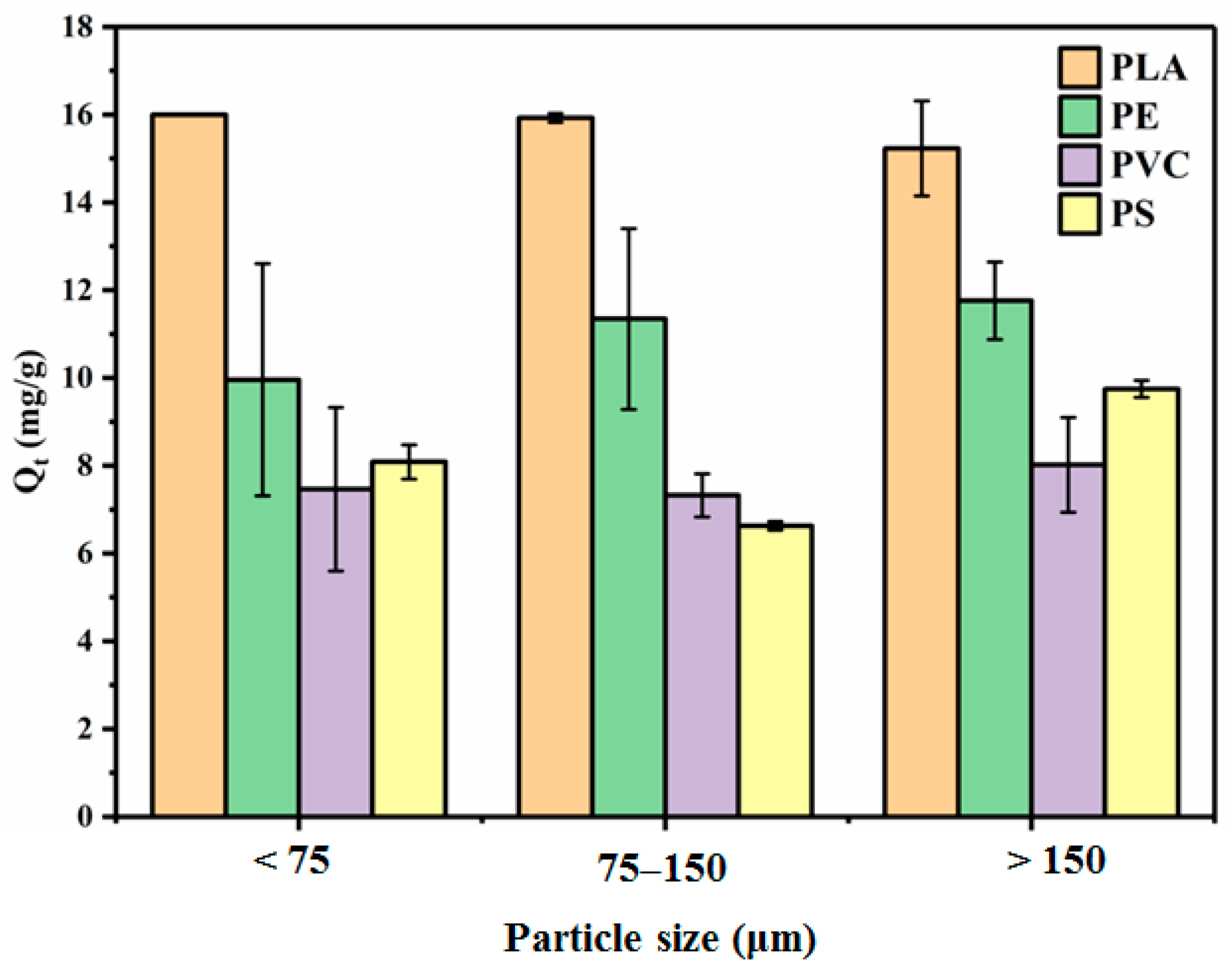
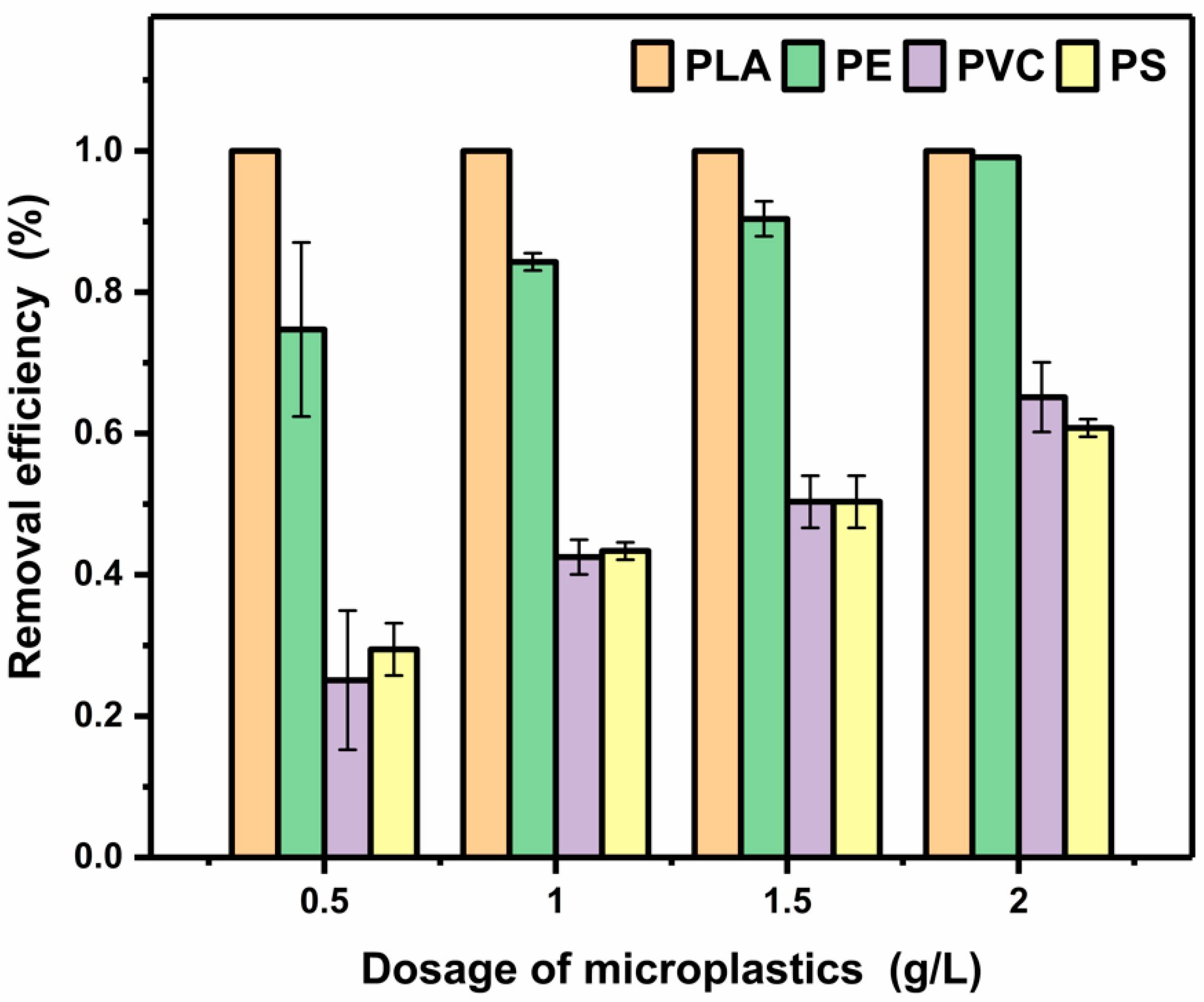
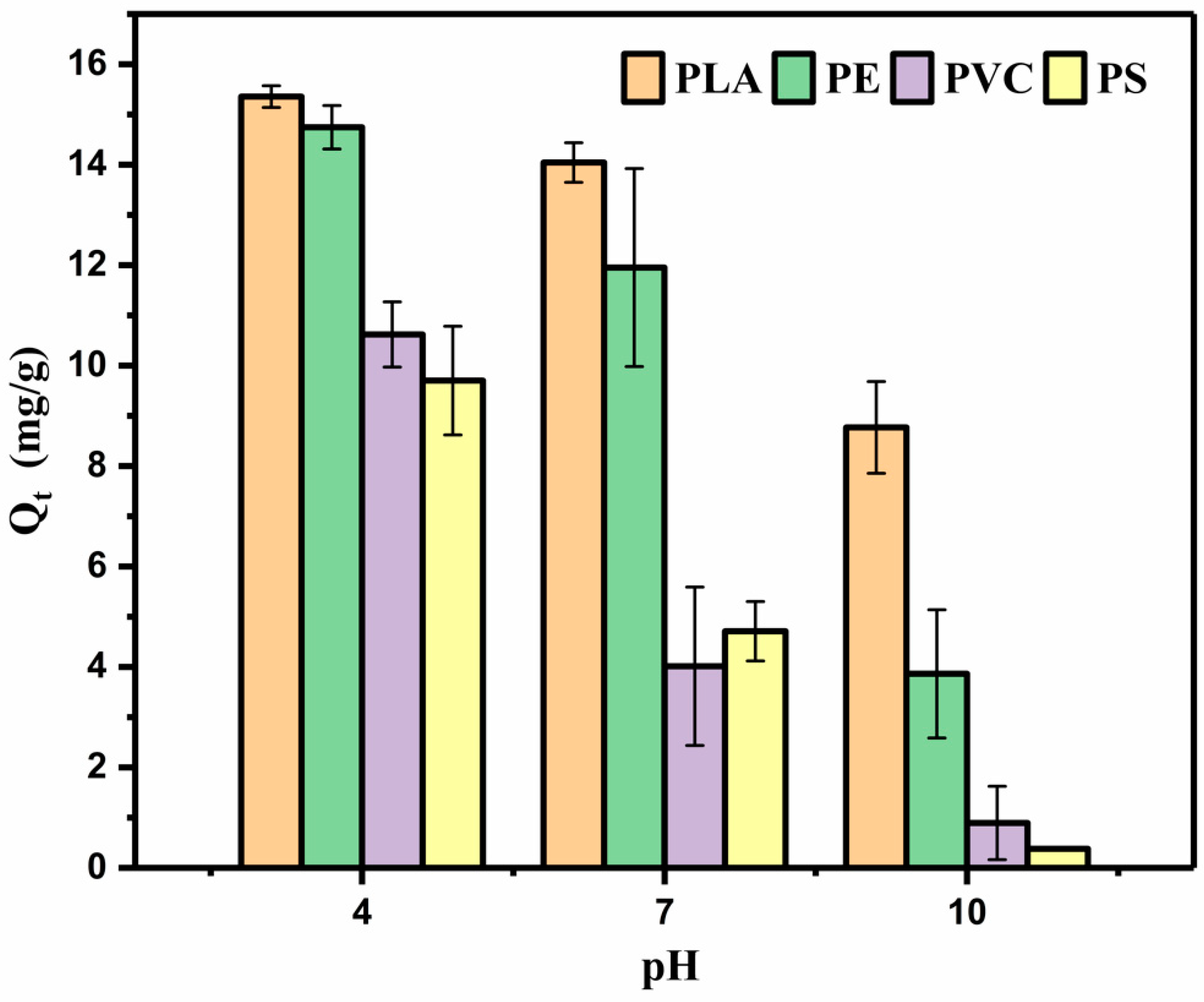
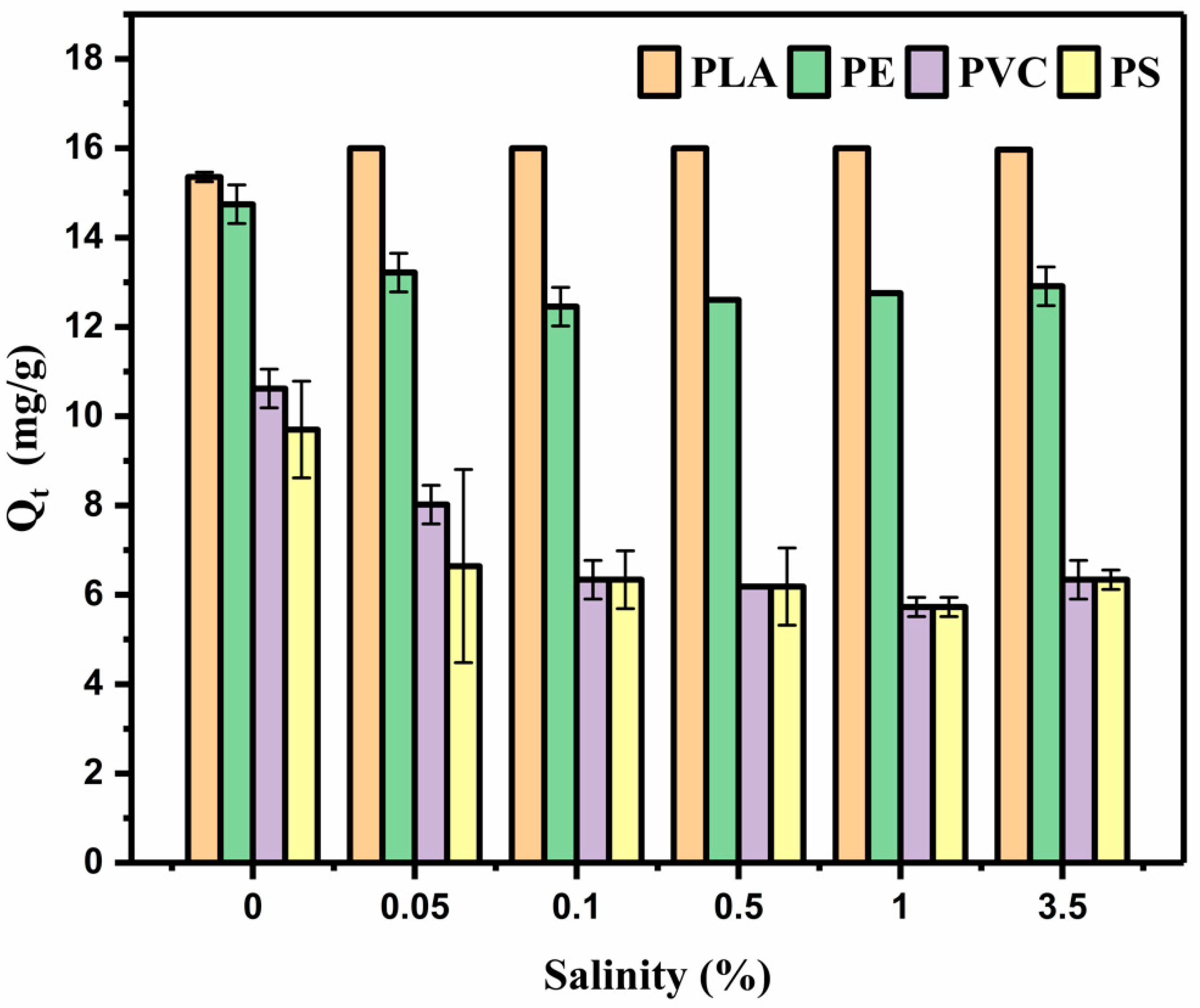
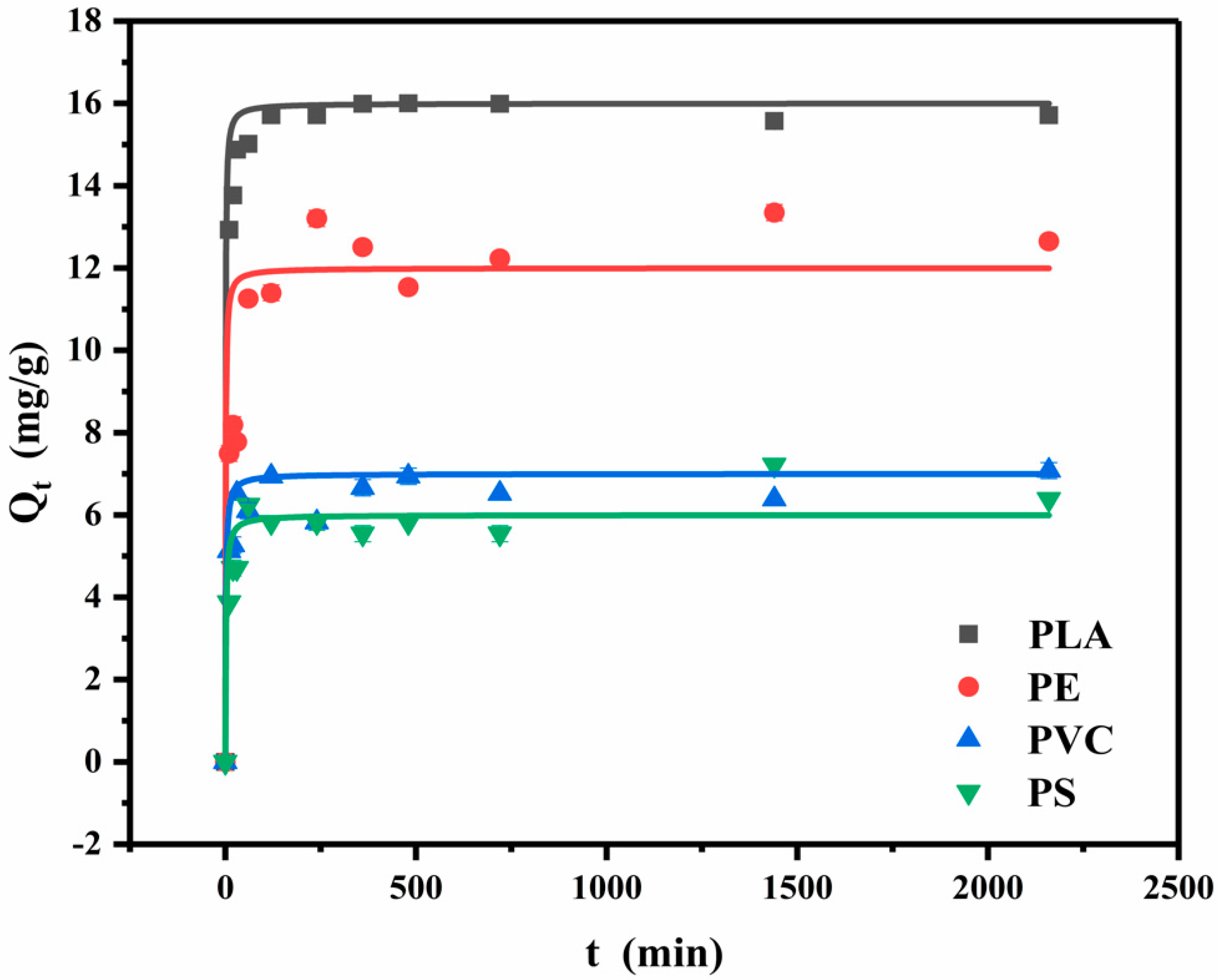
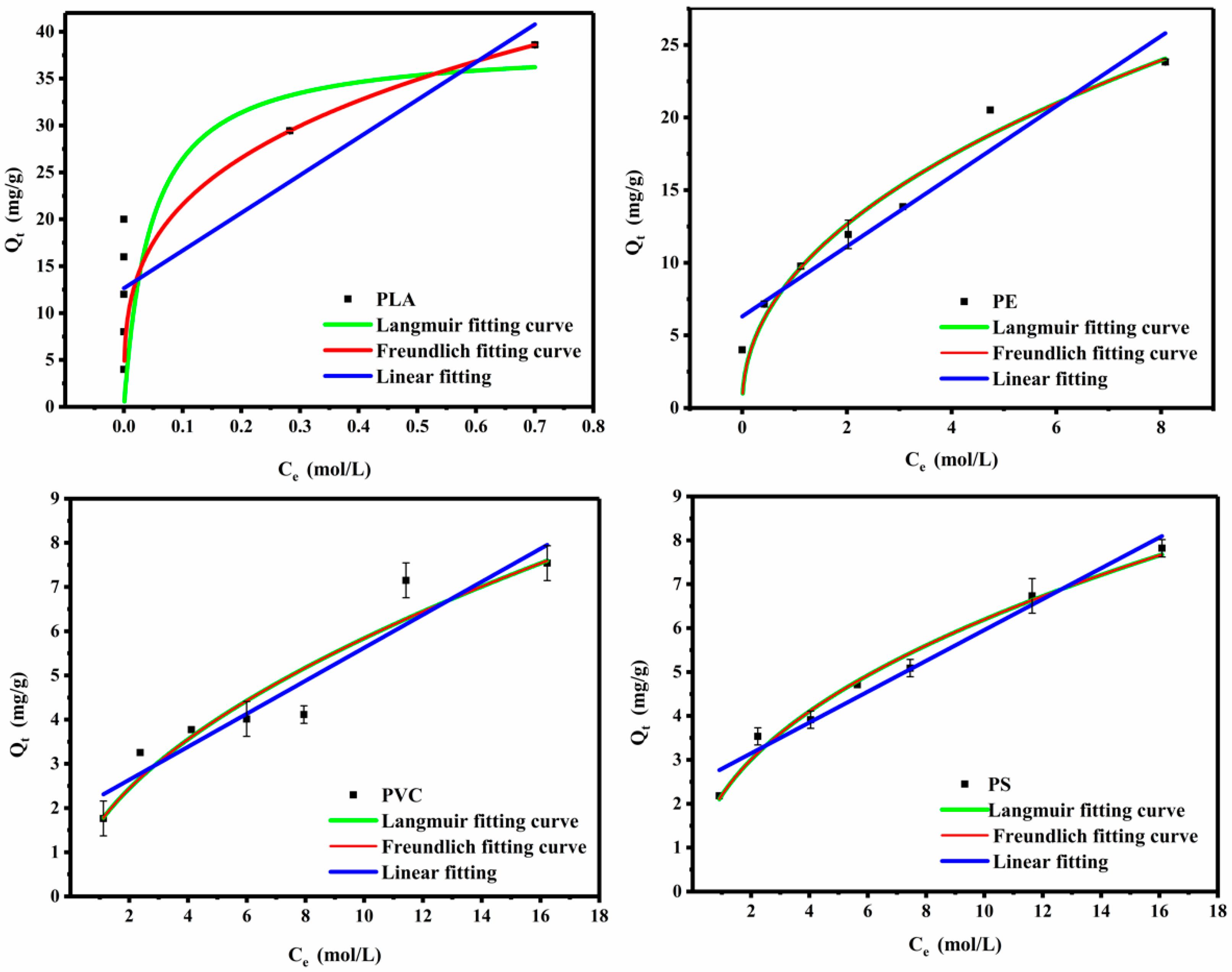
| Kinetics Model | Parameters | PLA | PE | PVC | PS |
|---|---|---|---|---|---|
| pseudo-first order | K1 (h−1) | 0.159 | 0.055 | 0.130 | 0.082 |
| Qe (mg g−1) | 15.6 | 12.2 | 6.52 | 5.99 | |
| R2 | 0.987 | 0.914 | 0.948 | 0.917 | |
| pseudo-second order | K2 (g mg−1 h−1) | 0.026 | 0.008 | 0.046 | 0.026 |
| Qe (mg g−1) | 15.9 | 12.7 | 6.67 | 6.18 | |
| R2 | 0.998 | 0.955 | 0.959 | 0.933 |
| Isotherm Model | Constants | PLA | PE | PVC | PS |
|---|---|---|---|---|---|
| Freundlich model | KF (mg kg−1) (mg L−1)−n | 42.9 | 9.19 | 1.68 | 2.20 |
| n | 0.300 | 0.460 | 0.542 | 0.450 | |
| R2 | 0.999 | 0.967 | 0.909 | 0.984 | |
| Langmuir model | KL (L mg−1) | 21.7 | 0.354 | 0.113 | 0.196 |
| Qm (mg g−1) | 38.6 | 31.3 | 11. 4 | 9.64 | |
| R2 | 0.528 | 0.767 | 0.709 | 0.784 | |
| Linear model | Kd (L mg−1) | 40.2 | 2.41 | 0.373 | 0.351 |
| R2 | 0.780 | 0.940 | 0.900 | 0.971 |
Publisher’s Note: MDPI stays neutral with regard to jurisdictional claims in published maps and institutional affiliations. |
© 2022 by the authors. Licensee MDPI, Basel, Switzerland. This article is an open access article distributed under the terms and conditions of the Creative Commons Attribution (CC BY) license (https://creativecommons.org/licenses/by/4.0/).
Share and Cite
Lang, Z.; Xue, L. Can Polylactic Acid (PLA) Act as an Important Vector for Triclosan? Sustainability 2022, 14, 12872. https://doi.org/10.3390/su141912872
Lang Z, Xue L. Can Polylactic Acid (PLA) Act as an Important Vector for Triclosan? Sustainability. 2022; 14(19):12872. https://doi.org/10.3390/su141912872
Chicago/Turabian StyleLang, Zihan, and Lidong Xue. 2022. "Can Polylactic Acid (PLA) Act as an Important Vector for Triclosan?" Sustainability 14, no. 19: 12872. https://doi.org/10.3390/su141912872
APA StyleLang, Z., & Xue, L. (2022). Can Polylactic Acid (PLA) Act as an Important Vector for Triclosan? Sustainability, 14(19), 12872. https://doi.org/10.3390/su141912872





